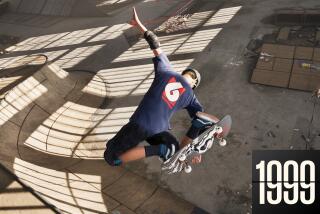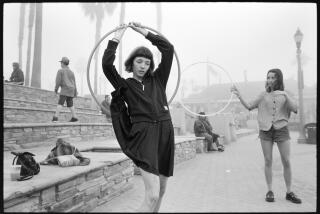Skate of the Art : Design Moves Fast-Forward on Wheels
When I first heard Johnny Tillotson sing “Poetry in Motion,” I misheard the words and thought the song began: “O, a tree in motion.”
I suppose that would be a fair description of a skateboard. Well, all right, it’s a bit of a tree in motion. It is a flying platform, a portable podium, a miniature stage for miraculous acrobatics. It’s akin to roller skates--a personal danger, a public nuisance, hell on wheels. And oftentimes, today, it is also a work of art.
Skateboards are bursting into pattern and design. It is an art, not unlike that of the poster, that makes an immediate impact by use of bold motifs and brilliant colors. (Poster artist Tom Purvis said that you should be able to catch the message of a poster as you pass it on a fast bus.)
The skateboard does not, so to speak, wear its art upon its sleeve. The bizarre designs are usually on the underside of the board. Why? Because the top of the board has to be covered with grip tape to stop the skateboarder’s feet from slipping. Usually this sandpaper-like material is black.
One of the bravest shows of skateboard art--a kind of gallery of the genre--is at Dave White’s store, Hot Skates, at 1122 E. Colorado St., Glendale. White, a former Southwest Pacific Coast roller-skating champion (he placed fifth in the National Roller-Skating Championships--governed by the U.S. Amateur Confederation of Rink Operators of America--in 1970), sells, services and repairs roller skates and skateboards. The boards are hung in rows to show their decoration.
Skulls and skeletons are among the most popular motifs. White does not believe that this macabre streak has anything to do with satanic cults. It just symbolizes the danger of skateboarding. “It’s hair-raising when you see the skateboarders ride on a ramp or in an empty swimming pool. A lot of parents come in with their kids and say, ‘Ugh! All these skulls; it’s terrible. I’m not buying that for my kid.’ But the kids that ride skateboards are mostly clean-cut. It is not a gang activity; it is an individual sport. When you are on a skateboard, you are that one and only person riding that skateboard.”
Powell Peralta Inc. of Santa Barbara, which in White’s view is among the best skateboard manufacturers, calls its wheels ‘bones.’ “When people come in and say, ‘Do you have any bones?’ I know exactly what they’re talking about,” White says. “Powell Peralta wheels.” One of Powell Peralta’s boards, named for skateboarder Mike McGill, is decorated with a skull around which a green rattlesnake coils.
For young skateboard performers, having a skateboard named after them is a form of immortality. Skateboarders seem to be at their peak in the 16- to-19 age group. The performer whom White most enjoys watching is Christian Hosoi, 18, whose name appears on many boards.
The Staab board (named for skateboarder Kevin Staab), made by Sims / Flash Vision Sports Inc., shows a mad scientist with green fingernails mixing a potion from two test tubes. It would be hard to get that onto a roller skate, or to fit onto that smaller ‘canvas’ the crazy eyes, in a fretwork of red, white and blue, on the ‘Psychotic’ board by Santa Cruz Inc. An advertisement for the ‘Psychotic’ board in “Transworld Skateboarding” (one of the magazines which, along with videos of the young marvels performing, are among the spinoffs of the skateboard industry) expresses in verse the philosophy of some skateboarders:
What a terror is my racing mind,
A vaporized reality had left me blind;
But with these eyes I’ve shattered my cage
And all who skate shall view my rage.
At 35, White is the granddaddy of skateboarding. Born and educated in Glendale, he began roller-skating at 8 and skateboarding four years later. “I tried to kill myself on clay wheels, which stuck on all the carob leaves and twigs; you’d find yourself flying through the air, almost always. In the late 1970s, the high-rebound wheel came in--that wouldn’t stop on small rocks or twigs.” His roller-skating career reached its zenith in 1984-85, when he received about $25,000 in fees and residual payments for his roller aerobatics in an IBM computer ad. (He doubled for actor Billy Scutter, who portrayed Charlie Chaplin; White ended his appearance with a cabaret click of the heels in the air.)
White’s heart is more in roller-skating than in skateboarding. “When you get in trouble,” he wryly observes, “you can’t get off a pair of roller skates. You can jump off a skateboard.”


